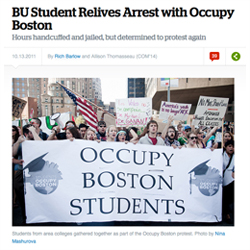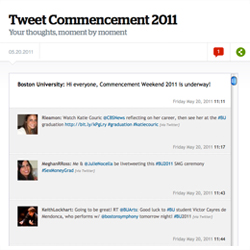
Last week, we talked about content and community in higher education. What is the role of content in online community management? What are the challenges and opportunities? Some smart higher ed community managers chimed in to share their thoughts on these questions and others.
Today, I’d like to dig a little deeper. I reached out to Jenny Mackintosh from Boston University to learn how she and other BU Marketing & Communications staff members approach content and community at one of the largest private universities in the U.S.
Mackintosh offered some wonderful examples, including methods of listening to your community for content ideas, using content to foster conversation, and measuring and responding to content to improve content quality and build a valued community.
What is the role of content in online community management?
Jenny Mackintosh: Content provides a dual purpose in community management: sparking new community conversation and reacting to what’s already being talked about. BU Today, Boston University’s daily news website, serves as a water cooler for hot-button campus issues (bikes, pedestrians and traffic on Commonwealth Avenue, for example). I don’t think we could stake a claim in the conversations at BU without contributing to them in stories, pictures and video. Across all of BU’s Marketing & Communications departments, we strive to keep unique content at the forefront of our strategy.
How can we plan for content that supports online community and social media goals?

Mackintosh: I’m a big advocate for allotting time to listen to what your campus community is actually saying. Set up a Twitter list of campus conversationalists. Subscribe to student and faculty blogs. Browse Tumblr for your school’s tag [see BU’s tag]. Attend or host events on campus where you can meet your community in person, like Dean Kenn Elmore’s Coffee and Conversation forum.
Here are a few great examples of BU Today stories that came out of listening to social media:
How did listening inform the creation of these BU Today stories?
Mackintosh: Dancing with the (Classroom) Stars, for example, came from a Tumblr post by a student who was involved in the planning of the event. Fancy Friday was discovered on Facebook, I think after the manager of the group’s page promoted it on the main BU Facebook page. It seems like a lot to listen for, but with a little setup time, checking these channels for ideas can become a quick daily task.
What are the content challenges you face in supporting your online community?

Mackintosh: One issue we face as content creators at Boston University is maintaining balance. We want to cover the lighthearted issues along with the heavier ones without making either seem trite or misplaced. We also know that maintaining credibility means welcoming criticism as well as praise, and then adapting. For example, when BU Today ran a fun trend piece on skinny jeans during the height of BU students’ participation in Occupy Boston, we received angry comments from some students that said we seemed out of touch. Shortly thereafter, BU Today ran a story on the Occupy movement that sparked a lot of conversation. Being flexible and willing to incorporate student voices when the tide changes is part of the content challenge in higher ed.
How do you plan for balanced, consistent content?
Mackintosh: An editorial calendar is essential to operations here, not only to make sure that the topics covered are evenly distributed, but also so that other teams, like PR, can plan on how it will be pitched. Some stories may lend themselves to external media interest, for example. Others may share well on social channels or provide a good gateway to a broader discussion. Of course, there’s always room for some shuffling of placement along the way, but the editorial team is very good at keeping an eye on at least a month’s worth of upcoming daily content and allotting even more planning time for longer series and our alumni magazine features.
Can you share an example of an online community-building initiative you have been a part of and how content contributed to its success?

Mackintosh: I think that last year’s coverage of commencement is a great example. At such a large university, it’s important to take note of the moments that bring the campus together. Our editorial, photography and videography teams did a great job of capturing last May’s commencement, but we put the power in students’ hands too. By using a hashtag and CoveritLive, we were able to bring the Class of 2011 together to create a digital mosaic of student- and staff-created content. For Marketing & Communications as a whole, it’s our busiest and perhaps most collaborative weekend, from what goes on the homepage to what’s in the programs, and how we’re capturing all of those moments in print and on the web.
I’ve also realized that not pointing to your own content is often just as important in community building. In maintaining BU Today’s social channels on Twitter and Facebook, I’ve learned that you can’t always be referring back just to what you’re publishing. Sometimes, students just want an answer to a question about what’s happening on the BU Beach. Even if we’re not covering it, we should be game to talk about it.
How do you measure success? What metrics do you use to evaluate content quality and delivery?
Mackintosh: Measuring success, as many in the higher ed web space know, is tough business because there are so many touch points along the way to a success story, and only some of those are on the web. We do measure how much traffic is coming from channels like Facebook, and how much they are being shared on Twitter, because it tells us which topics are most interesting to readers and what lends itself to sharing. We also look at the interactions that readers are having with our content – the comments on stories and the watch rates on videos are two examples.
What are some opportunities for using content in new or better ways for online community and social media efforts?
Mackintosh: Content repurposing is something I think a lot about. How do we take one story and make it useful several times over for admissions, alumni giving, or discussions on social media? If we’re spending the time to create this content, we should also be conscious of using the tools we have at hand to extend its life.
Do you have any success stories for repurposing and extending the life of content?
Mackintosh: Definitely. When brainstorming content, our editorial team is mindful of its life beyond that first iteration. Can it live on the homepage? Can it be used in an upcoming admissions or alumni-giving ad campaign? The "You at BU" campaign for Admissions is a great example. Many of the videos featured came originally from stories on BU Today and Bostonia.

Jenny Mackintosh
Public Relations Assistant at Boston University
Social media manager and consultant
@JennyMack
Boston University (@BU_Tweets)
BU Today (@BUToday)
BU Now
Social Media at BU

Good write up. BU seems to get a lot of things right. This is one of them.
note: the “BU’s tag” link is missing a ‘y’
Thanks for the feedback, Marc! (Broken link fixed!)
Rick